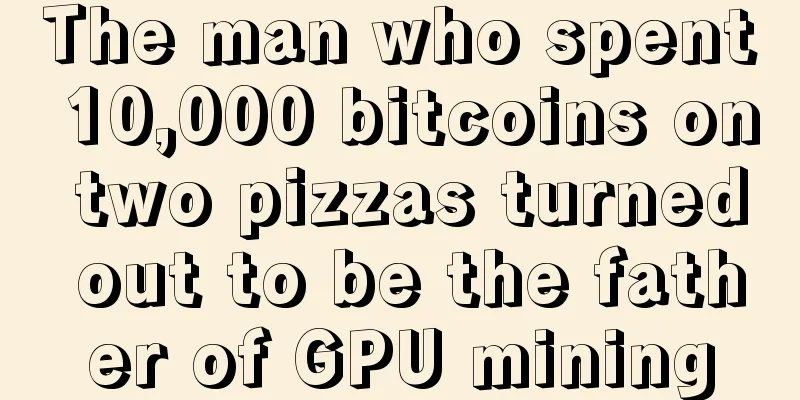The man who spent 10,000 bitcoins on two pizzas turned out to be the father of GPU mining

|
Original | Cainiao Blockchain Editor | Uncle Kuang A year after its birth, Bitcoin still trades for less than a penny. Much of the excitement about the world's first cryptocurrency lives on the forum Bitcointalk, where old-timers discuss economic philosophy, technical knowledge, and the new crypto-monster created by Satoshi Nakamoto. Satoshi himself is also active on the forum, where early users share their views on the future of the monetary system. The problem is that no one has ever bought anything with Bitcoin before. Darknet markets will not exist for several years, and all transactions by users (except for peer-to-peer transactions on the Internet) are cash transactions. Laszlo Hanyecz, Mr. Pizza, decided it was time to make history. On May 18, 2010, the Bitcoin Core contributor asked other Bitcoin enthusiasts on Bitcointalk if anyone would be willing to send him two large pizzas. He offered to pay 10,000 Bitcoins in return. Although it took four days, he finally made his wish come true. One prescient user warned that 10,000 Bitcoins would be “too expensive” to buy two pizzas—roughly $41 at the time. Of course, “too expensive” sounds like a ridiculous understatement today; seven years later, at Bitcoin’s all-time high, that sum would be worth $200 million. In an interview with Bitcoin Magazine, Hanitz said that using 1,000 bitcoins to buy a pizza was just a drop in the ocean at the time. We would give people bitcoins on the forum, sometimes 100, sometimes 1,000. I bought pizza because, to me, it was free pizza. I wrote the code for this thing, I mined Bitcoin, I felt accomplished that day, and I got pizza for participating in an open source project. Usually, hobbies are a waste of time and money, but in this case, my hobby bought me dinner. More than just Mr. Pizza This transaction, completed on May 22, 2010, will be etched in Bitcoin history. There’s more to Hanyecz’s story, though, and while this legendary pizza deal overshadows his other Bitcoin accomplishments, it also overlooks his other (and far more important) contribution to Bitcoin’s development: GPU mining. He was one of the first contributors to Bitcoin before the mining industry changed. He joined Bitcoin in late 2009 and has been working on research and bug fixes, with his "minor" contributions including building and deploying the first Bitcoin Core version for macOS. His contributions also include improving the mining environment. Hanitz first introduced GPU mining to the community in May 2010. At that time, he thought it was just an experiment, but he didn't know it was the spring breeze of reform in the mining industry. “On Bitcointalk at the time, there weren’t really any users,” he recalled. “There were 50, maybe 100 people. It was very different back then. It was like, ‘Hey, do you want to contribute to open source projects?’ It wasn’t, ‘Hey, do you want money to change the world?’” At the time, the only Bitcoin mining was done on the power of CPUs — the processors that make personal computers work. No one had figured out a more efficient way to produce blocks. While working on improving efficiency, Hanyecz admitted that he didn’t fully understand “how quickly [mining] difficulty adjusts” (since no one had yet created a miner powerful enough to really test the mechanism). Still, he was thinking about how to generate more blocks faster, and thus extract more value from the Bitcoin network. It was this that led him to design a mining code using GPUs. Graphics processing units animate our computer screens with colors and graphics. Hanitz reasoned that these hardware can complete more calculations at once than CPUs, making them ideal for "brute force" mining. “What GPUs are good at is they can do a lot of things in parallel, but they have to be very simple things, and they have to be the same thing,” he explained. “So, you can add 10 to a thousand different numbers at the same time. Whereas a regular, regular CPU is much more flexible. It can do a lot of things, but it has to do them one at a time. The mining problem is completely a GPU problem.” His discovery was profitable. It allowed him to increase his computing power tenfold—and that was using a 2010 Macbook! But his discovery was not recognized by the crypto pioneers. Hanyecz said that in those days, Satoshi always "kept his distance" from him, but after he shared the GPU mining code with the creator, Satoshi expressed his opinion that it was too advanced for the development of Bitcoin. “The fact that regular computers can mine Bitcoin is a huge attraction for new users,” Nakamoto wrote in an email to Hanyecz. “GPUs will prematurely limit incentives to companies that only have high-end GPU hardware. It’s inevitable that GPU computing clusters will eventually take all the Bitcoins generated, but I don’t want to hasten that day.” “That’s when I was like, ‘Man, I think I screwed your project.’ ” Hanyecz told Bitcoin Magazine with a laugh. He was concerned that people might be frustrated that they couldn’t use their CPUs to mine a block. “So, after that, I stopped advertising.” Even though he tried to stop it, Hanyecz’s invention quickly spread, opening a Pandora’s box of hashrate on the network. Soon after he first published the code on Bitcointalk, other users used it to create standalone versions for Windows, Mac, and Linux. Hanyecz released the groundbreaking code as a patch to the Bitcoin Core source code. However, these new versions are completely separate from Bitcoin Core and exist independently. The secret was out, and Hanyecz no longer had the competitive advantage he was seeking when coding a new mining method. “I thought having more processing power would ensure the security of the network. But it didn’t occur to me that I should keep this a secret and that greed would make more sense,” he joked. Life after the pizza incident Despite the misconception that Hanyecz shunned Bitcoin after the pizza deal, he still exists. He’s just no longer actively involved in Bitcoin development. “I’m just another Bitcoin creator,” said the man who revolutionized the mining landscape. Confusingly, nearly a decade later, the same man has received little recognition for this contribution. Instead, most people know Laszlo Hanyecz for his involvement in the historic pizza deal, an industry meme that dwarfs his more groundbreaking work during Bitcoin’s faltering infancy. This may also be a result of his invention of Bitcoin, when its followers were less than a few hundred enthusiasts. However, in this era of social networks, the shock value of his purchase far outweighs the technical achievements on his cypherpunk resume. Asked if he's tired of people asking him about his purchases, Hanitz said he sees it differently. “I think it’s interesting that people look at it that way,” he explained. “I think it’s something that’s easy to get caught up in. But I think anyone who’s actually interested [in Bitcoin] can understand it. It’s the same thing as, oh, let me go back in time and buy Apple stock.” “It was Monopoly money at the time. Nobody cared because it had no real value, so I didn’t think I needed to be greedy about it.” The father of GPU mining seems to be treating the infamous pizza deal and the issues surrounding it the same way he treats Bitcoin: with a sense of humor and deep regret. In fact, he doesn’t see it as a loss; he sees it as a win. “The deal happened because both parties thought it was a good deal,” he said. “I felt like I had done something that disrupted the traditional internet and got free food for it. I linked these GPUs together and now I can mine twice as fast. I can mine more Bitcoins and I only eat free food, I never have to buy food again. Hanitz has maintained this optimistic outlook despite Bitcoin’s continued breakout of all-time highs over the years, likely because his attitude toward Bitcoin has not changed since he first joined the open-source community in 2010. For him, it’s still a hobby, not a career. “To be honest, I just kind of stayed out of it because there was so much gossip,” he said. “I didn’t want that attention, and I certainly didn’t want people to think I was Satoshi… I just felt like it was better as a hobby. “I have a regular job. I’m not doing Bitcoin full-time. I don’t want this to be a career goal. I’m just glad I was able to be involved to this extent.” We’re glad he is, too. After all, he’s the man who gave us the Bitcoin Core code for MacOS and GPU mining — oh, and Bitcoin’s pizza culture. They may not be as significant as Hanyecz’s other contributions, but they sure make May 22nd memorable (and delicious) for the community every year. Disclaimer: Mining is risky and investment should be cautious. This article is purely the author's personal opinion and does not provide any investment advice. This article is reprinted from Odaily Planet Daily. If you need to reprint, please contact the original author. |
<<: Bitcoin could hit $50,000? Some traders may actually think so!
>>: Bitcoin's Past and Future: Where Are We Going?
Recommend
Don’t marry men with these two types of facial features! They all have the face of a wife killer.
The face of a man who cannot be married 1. The ro...
What does it mean if a girl has a mole under her ear? Does it mean she is destined to be rich?
One of the important factors that influence desti...
Acne tells you where you are sick. How to treat acne on your face?
Acne tells you where you are sick. How to treat a...
Mole location and destiny - what does a mole on a woman's waist mean
If a woman has a mole on her waist, just behind h...
Tips for mole physiognomy on the whole body, predictions for mole physiognomy on the body and limbs
Tips for mole physiognomy on the whole body, pred...
How many countries’ legal currencies can buy all Bitcoins?
Bitcoin is currently valued at $66,500 and is on ...
A man with three white eyes and a strong temper is a sign of bad luck to his wife
Does a man with three white eyes bring bad luck t...
What does a scheming and cunning woman look like?
A woman's heart is as unfathomable as the sea....
People with these facial features are most likely to offend others, so you need to be more careful!
People with these facial features are most likely...
What influence will the mole on the palm have on our future?
People with moles on their palms are generally st...
Boy's left hand broken palm_palm analysis
In ancient times, a man's broken palm was con...
What kind of palmistry indicates bad career luck
A successful career seems to mean both fame and f...
Is it good for a man to have a mole on his instep? What does a mole on the instep mean?
Is it good to have a mole on the instep? Compared...
Panorama of blockchain: “Blockchain + Finance” takes the lead
We discussed the issue of how far blockchain has ...
The face of a couple who will file for divorce after a quarrel
It is very common for couples to quarrel. After a...









